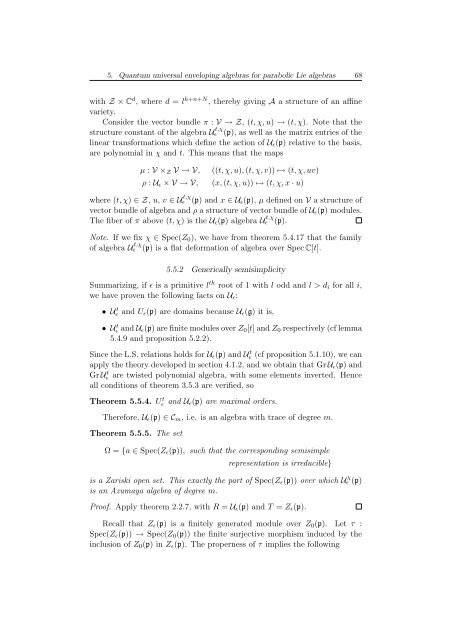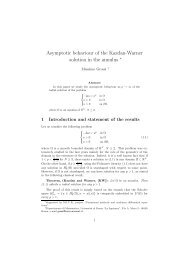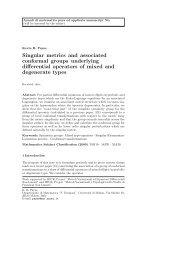Degree of Parabolic Quantum Groups - Dipartimento di Matematica ...
Degree of Parabolic Quantum Groups - Dipartimento di Matematica ...
Degree of Parabolic Quantum Groups - Dipartimento di Matematica ...
You also want an ePaper? Increase the reach of your titles
YUMPU automatically turns print PDFs into web optimized ePapers that Google loves.
5. <strong>Quantum</strong> universal enveloping algebras for parabolic Lie algebras 68<br />
with Z × C d , where d = l h+n+N , thereby giving A a structure <strong>of</strong> an affine<br />
variety.<br />
Consider the vector bundle π : V → Z, (t, χ, u) → (t, χ). Note that the<br />
structure constant <strong>of</strong> the algebra U t,χ<br />
ǫ (p), as well as the matrix entries <strong>of</strong> the<br />
linear transformations which define the action <strong>of</strong> Uǫ(p) relative to the basis,<br />
are polynomial in χ and t. This means that the maps<br />
µ : V ×Z V → V, ((t, χ, u), (t, χ, v)) ↦→ (t, χ, uv)<br />
ρ : Uǫ × V → V, (x,(t, χ, u)) ↦→ (t, χ, x · u)<br />
where (t, χ) ∈ Z, u, v ∈ U t,χ<br />
ǫ (p) and x ∈ Uǫ(p), µ defined on V a structure <strong>of</strong><br />
vector bundle <strong>of</strong> algebra and ρ a structure <strong>of</strong> vector bundle <strong>of</strong> Uǫ(p) modules.<br />
The fiber <strong>of</strong> π above (t, χ) is the Uǫ(p) algebra U t,χ<br />
ǫ (p).<br />
Note. If we fix χ ∈ Spec(Z0), we have from theorem 5.4.17 that the family<br />
<strong>of</strong> algebra U t,χ<br />
ǫ (p) is a flat deformation <strong>of</strong> algebra over Spec C[t].<br />
5.5.2 Generically semisimplicity<br />
Summarizing, if ǫ is a primitive l th root <strong>of</strong> 1 with l odd and l > <strong>di</strong> for all i,<br />
we have proven the following facts on Uǫ:<br />
• U t ǫ and Uǫ(p) are domains because Uǫ(g) it is,<br />
• U t ǫ and Uǫ(p) are finite modules over Z0[t] and Z0 respectively (cf lemma<br />
5.4.9 and proposition 5.2.2).<br />
Since the L.S. relations holds for Uǫ(p) and U t ǫ (cf proposition 5.1.10), we can<br />
apply the theory developed in section 4.1.2, and we obtain that Gr Uǫ(p) and<br />
Gr U t ǫ are twisted polynomial algebra, with some elements inverted. Hence<br />
all con<strong>di</strong>tions <strong>of</strong> theorem 3.5.3 are verified, so<br />
Theorem 5.5.4. U t ǫ and Uǫ(p) are maximal orders.<br />
Therefore, Uǫ(p) ∈ Cm, i.e. is an algebra with trace <strong>of</strong> degree m.<br />
Theorem 5.5.5. The set<br />
Ω = {a ∈ Spec(Zǫ(p)), such that the correspon<strong>di</strong>ng semisimple<br />
representation is irreducible}<br />
is a Zariski open set. This exactly the part <strong>of</strong> Spec(Zǫ(p)) over which U χ ǫ (p)<br />
is an Azumaya algebra <strong>of</strong> degree m.<br />
Pro<strong>of</strong>. Apply theorem 2.2.7, with R = Uǫ(p) and T = Zǫ(p).<br />
Recall that Zǫ(p) is a finitely generated module over Z0(p). Let τ :<br />
Spec(Zǫ(p)) → Spec(Z0(p)) the finite surjective morphism induced by the<br />
inclusion <strong>of</strong> Z0(p) in Zǫ(p). The properness <strong>of</strong> τ implies the following








